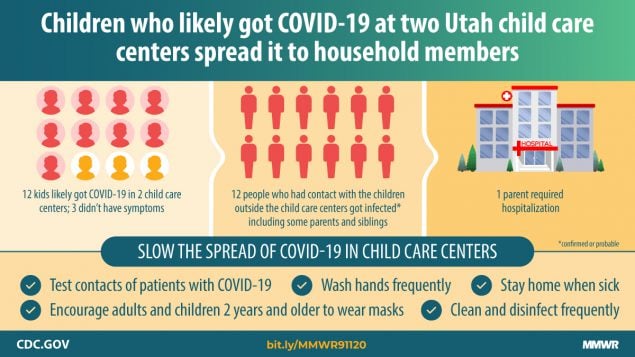From our follower Question Box!!
A: Yes, while we know that children are less likely to experience severe illness due to COVID-19, increasing evidence tells us that children can spread (transmit) the virus. But, it is not clear if they are more likely to do so than adults or if likelihood of transmission varies by age. Several recent reports on outbreaks in child care facilities help to highlight the latest evidence.
TL; DR: Children can transmit the virus to their household contacts. Good non-pharmaceutical interventions [(NPIs) masking, distance, limiting numbers, good hygiene, and regular testing help decrease the risk of transmission within child care facilities.
Previous evidence has suggested that transmission can happen in the school setting, but little data was available on child care facilities. Two reports from Rhode Island and Utah shed light on transmission.
Rhode Island: Child care facilities opened in June 2020 and data was collected from June 1, 2020-July 31, 2020. 4 daycare programs had new cases-these programs did not seem to be implementing state guidelines (low enrollment, consistent groups, universal masking, daily screening, and enhancing hygiene protocols). In the Rhode Island context, new cases increased slightly, however NPIs worked (Excellent explainer from our colleague YLE.)
Utah (NEW): Summary-Index cases were associated with adults at the facilities. Children who became infected transmitted to household and non-household contacts.
Three child care facilities were examined for transmission within the facility. Staff wore masks. Students did not. All used daily symptom screening, temperature screening, and increased hygiene practices to varying degrees.
-Facility A: The index case (the original case) was a staff member and another staff member was infected. Total cases: Two (adults). Attack rate (how many people became sick in the population) at facility was 17% (2 of 12) and 7% overall from the contacts of the two cases (2 of 27).
-Facility B: The index case was a staff member and there were a total of 5 cases (3 adults and 2 children). The staff member was not symptomatic but was caring for a household member with COVID-19; after testing the staff member did not go to work and was not symptomatic for four days after stopping work. Two staff members were infected. Two children (8 months and 8 years) were infected and likely transmitted to their households/contacts (one child’s parents and three other contacts). Facility attack rate was 100% (5 of 5) and overall attack rate was 36% (12 of 33).
-Facility C: There were 15 total cases (5 staff members and 10 children). The index case was a staff member, then 4 more staff members and 10 students were infected. Children likely transmitted to their household/contacts including 5 cases confirmed (3 mothers, 1 aunt, 1 child) and 2 probable (mother/child). The source of the outbreak was unknown. Facility attack rate was 18% (15 of 84) and overall attack rate was 19% (24 of 124).
The bottom line: Evidence suggests that children can transmit the virus to household and non-household contacts. It is important, particularly in child care facilities, that NPIs continue to be emphasized, particularly: staying home when a household contact is sick, masking, hand hygiene, and good cleaning/disinfecting processes.
We hope that this helps clarify the link between children and transmission in child care facilities. We will continue to update as data emerge.
With love,
Those Nerdy Girls



